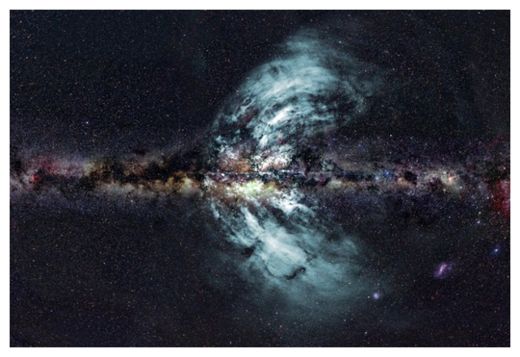Monster outflows pouring out of Milky Way's center

The new-found outflows of particles (pale blue) from the galactic Center. The background image is the whole Milky Way at the same scale. The curvature of the outflows is real, not a distortion caused by the imaging process.
Astronomers using CSIRO's 210-feet Parkes radio telescope in eastern Australia have found monstrous outflows of charged particles coming from the center of our galaxy.
The researchers said that the outflows contain an extraordinary amount of energy, reaching about a million times the energy of an exploding star.
Although the outflows are shooting out at over 600 miles per second, but they pose no danger to Earth or the solar system.
"They are not coming in our direction, but go up and down from the galactic plane," said CSIRO's Dr. Ettore Carretti. "We are 30,000 light-years away from the galactic center, in the plane. They are no danger to us."
The outflows extend 50,000 light-years from top to bottom out of the galactic plane, which equals half the diameter of the Milky Way.
Astronomers said the outflows stretch about two-thirds across the sky from horizon to horizon, and correspond to a "haze" of microwave emission previously spotted by the WMAP and Planck space telescopes.
These telescopes did not provide enough evidence to indicate definitively the source of the radiation they detected, but the new Parkes observations do.
"The options were a quasar-like outburst from the black hole at the galactic center, or star-power - the hot winds from young stars, and exploding stars," said team member Dr. Gianni Bernardi of the Harvard-Smithsonian Center for Astrophysics. "Our observations tell us it's star-power."
The outflows appear to have been driven by many generations of stars forming and exploding in the galactic center over the past hundred million years. In order to determine this, astronomers had to measure the outflows' magnetic fields.
"We did this by measuring a key property of the radio waves from the outflows - their polarization," said team member Dr. Roland Crocker of the Max-Planck-Institut fuer Kernphysik in Heidelberg, Germany, and the Australian National University.
The latest observations of the outflows help to answer one of astronomy's biggest questions about our galaxy: how it is able to generate and maintain its magnetic field.
"The outflow from the galactic center is carrying off not just gas and high-energy electrons, but also strong magnetic fields," said team member Dr. Marijke Haverkorn of Radboud University in The Netherlands. "We suspect this must play a big part in generating the galaxy's overall magnetic field."


When the galactic center is as close as possible to directly overhead you are most sensitive to psi phenomena.The best time to try to intuit those lottery numbers...it really effects my remote viewing results.
It will occur roughly 10:15 AM tomorrow Jan 18th. It gets stronger as you approach that time and much weaker afterwards. Due to the Earths rotation, it happens once a day and also you are sensitive 12 hours later for the second strongest effect. I'm going to foward this story to my RV group's leader. A little more info might help us to understand the cause. Thanks for the post.